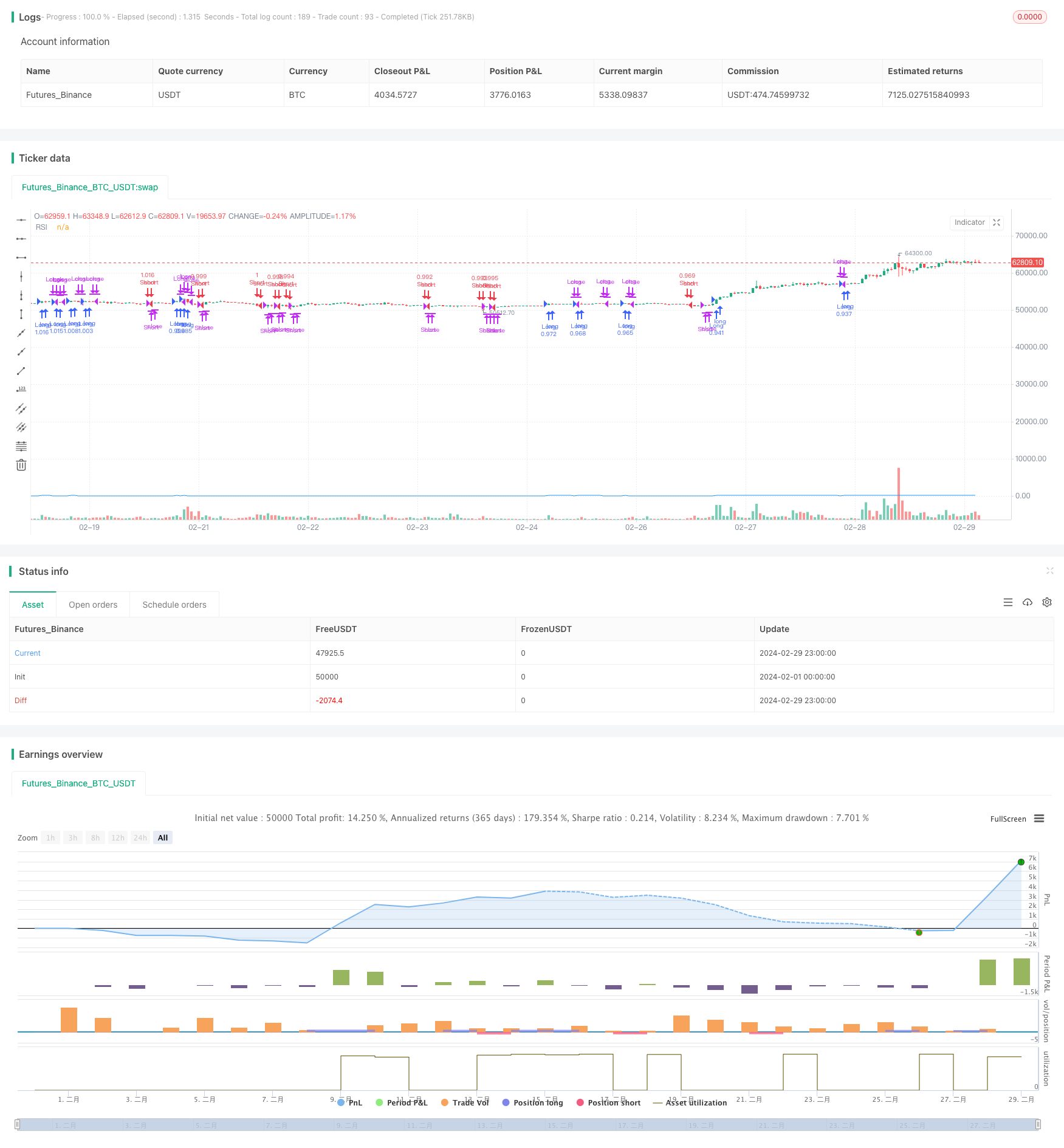
概述
RSI双向交易策略与初始止损是一个基于相对强弱指数(RSI)技术指标的量化交易策略。该策略利用RSI指标在超买和超卖区域的反转特性,通过在RSI指标突破特定阈值时进行多头或空头交易,并设置初始止损来管理风险,以期获得稳定的交易收益。该策略适用于趋势明显的股票的小时图表交易。
策略原理
该策略的核心是RSI指标,RSI指标是衡量市场价格变动趋势的动量指标,通过比较一段时间内价格上涨日的平均涨幅和下跌日的平均跌幅来反映市场的超买和超卖状态。一般来说,当RSI指标高于70时,表明市场处于超买状态,价格可能面临回调压力;当RSI指标低于30时,表明市场处于超卖状态,价格可能有反弹的机会。
该策略的交易逻辑如下:
- 计算指定周期(默认为14)的RSI指标。
- 当前一个小时的RSI指标小于60,当前小时的RSI指标大于等于60时,开仓做多;当前一个小时的RSI指标大于60,当前小时的RSI指标小于等于60时,平仓多头头寸。
- 当前一个小时的RSI指标大于40,当前小时的RSI指标小于等于40时,开仓做空;当前一个小时的RSI指标小于40,当前小时的RSI指标大于等于40时,平仓空头头寸。
- 在开仓时,同时设置一个初始止损价格,默认为开仓价格的6%,以控制单笔交易的最大风险。
通过上述交易逻辑,该策略可以在RSI指标突破关键阈值时及时开仓,在RSI指标回到关键阈值内时及时平仓,以期捕捉市场趋势,获得交易收益。同时,设置初始止损可以有效控制单笔交易的最大损失,提高策略的风险控制能力。
优势分析
RSI双向交易策略与初始止损具有以下优势:
- 趋势跟踪能力强:RSI指标是一个有效的趋势跟踪指标,通过RSI指标的突破和回归,该策略可以较好地捕捉市场的主要趋势,适应不同的市场行情。
- 双向交易机会:该策略通过在超买区域做空,超卖区域做多,可以在多空双方向上获得交易机会,提高了策略的适应性和获利能力。
- 风险控制机制:通过设置初始止损,该策略可以有效控制单笔交易的最大损失,降低了策略的整体风险。
- 参数灵活可调:该策略的关键参数如RSI指标周期、超买超卖阈值、初始止损比例等均可根据市场特点和个人偏好进行灵活调整,提高了策略的适应性。
- 逻辑清晰简单:该策略的交易逻辑清晰简单,易于理解和实现,适合量化交易新手学习和使用。
风险分析
尽管RSI双向交易策略与初始止损具有一定的优势,但它也存在以下潜在风险:
- 趋势识别风险:RSI指标虽然是一个有效的趋势跟踪指标,但在某些市场情况下,如震荡市或趋势反转初期,RSI指标可能发出错误信号,导致策略出现亏损。
- 参数优化风险:该策略的关键参数如RSI指标周期、超买超卖阈值等对策略绩效有重要影响,参数的优化和选择需要大量的历史数据和回测验证,不当的参数设置可能导致策略绩效不佳。
- 初始止损风险:尽管设置初始止损可以控制单笔交易的最大损失,但如果初始止损设置不当,可能导致策略频繁止损,错失潜在的获利机会,降低策略收益。
- 市场风险:该策略在趋势明显的市场中表现较好,但在市场出现大幅波动、重大事件冲击等情况下,策略可能面临较大回撤风险。
- 套利风险:该策略在开仓时可能面临滑点、交易成本等套利风险,影响策略的实际收益。
针对上述风险,可以采取以下措施加以应对:
- 结合其他技术指标如移动平均线、MACD等,对RSI指标信号进行二次确认,提高趋势识别的准确性。
- 在历史数据上进行大量回测,优选关键参数,并定期检验和调整参数设置,以适应市场变化。
- 优化初始止损设置,如采用ATR等动态止损方式,提高止损的灵活性和有效性。
- 密切关注市场风险事件,必要时对策略进行降低仓位、暂停交易等风险控制操作。
- 选择交易成本低、流动性好的标的,合理控制单笔交易的资金量,降低套利风险的影响。
优化方向
RSI双向交易策略与初始止损还可以在以下方面进行优化和改进:
- 引入多空仓位管理模块:在现有策略基础上,可以根据市场趋势强度、波动率等指标,动态调整多空头寸的仓位比例,在趋势强劲时加大仓位,在趋势减弱或反转时减小仓位,提高策略的灵活性和盈利能力。
- 优化止损和止盈机制:在现有的初始止损基础上,可以引入追踪止损、滑动止盈等动态止损止盈机制,根据市场波动特点和个人风险偏好,动态调整止损止盈点位,提高策略的盈亏比和风险控制能力。
- 结合多周期分析:在现有的小时图表基础上,可以引入日线、5分钟等多个周期的RSI指标分析,通过多周期RSI指标的共振和背离,提高趋势判断的准确性和可靠性。
- 引入市场情绪分析:RSI指标本身就是一个情绪指标,可以在策略中引入其他市场情绪指标如VIX恐慌指数、牛熊指数等,通过量化市场情绪,对RSI指标信号进行过滤和确认,提高策略的稳健性。
- 加入资金管理模块:可以在策略中引入Kelly准则、固定比例资金管理等资金管理方法,根据策略的历史表现和回测结果,合理配置每笔交易的资金比例,提高策略的长期稳定性和可持续性。
通过上述优化和改进措施,可以进一步提升RSI双向交易策略与初始止损的性能和稳健性,更好地适应不同的市场行情和交易需求。
总结
RSI双向交易策略与初始止损是一个基于RSI指标趋势特性的量化交易策略,通过在RSI指标超买超卖区域设置开平仓信号,同时设置初始止损来控制风险,以期获得稳定的交易收益。该策略逻辑清晰简单,具有趋势跟踪能力强、双向交易机会多、风险控制机制完善等优势,适合量化交易新手学习和使用。
但该策略也存在趋势识别风险、参数优化风险、初始止损风险、市场风险和套利风险等潜在问题,需要通过结合其他技术指标、优化关键参数、动态调整止损止盈、关注市场风险事件、控制交易成本等措施来加以应对和改进。
此外,该策略还可以通过引入多空仓位管理、动态止损止盈、多周期分析、市场情绪分析、资金管理等模块来进一步优化和提升,以更好地适应不同的市场行情和交易需求,提高策略的盈利能力、稳健性和可持续性。
总之,RSI双向交易策略与初始止损是一个简单实用的量化交易策略,通过合理的优化和改进,可以成为量化交易者的有力工具,帮助他们在金融市场中获得长期稳定的收益。但任何策略都有其局限性和风险,量化交易者需要根据自己的风险偏好、交易经验和市场环境,审慎选择和应用策略,时刻保持谨慎和风险意识,才能在量化交易的道路上走得更稳、更远。
/*backtest
start: 2024-02-01 00:00:00
end: 2024-02-29 23:59:59
period: 1h
basePeriod: 15m
exchanges: [{"eid":"Futures_Binance","currency":"BTC_USDT"}]
*/
//@version=5
strategy("RSI Long and Short Strategy with Initial Stop Loss", overlay=true, default_qty_type=strategy.percent_of_equity, default_qty_value=100)
// Input parameters
rsi_length = input(14, title="RSI Length")
initial_stop_loss_percentage = input(6, title="Initial Stop Loss Percentage")
// Calculate RSI
rsi_1hour = request.security(syminfo.tickerid, "60", ta.rsi(close, rsi_length))
// Entry condition for Long trades
long_entry = rsi_1hour[1] < 60 and rsi_1hour >= 60
// Exit condition for Long trades
long_exit = rsi_1hour[1] > 60 and rsi_1hour <= 60
// Entry condition for Short trades
short_entry = rsi_1hour[1] > 40 and rsi_1hour <= 40
// Exit condition for Short trades
short_exit = rsi_1hour[1] < 40 and rsi_1hour >= 40
// Initial Stop Loss calculation
initial_stop_loss_long = close * (1 - initial_stop_loss_percentage / 100)
initial_stop_loss_short = close * (1 + initial_stop_loss_percentage / 100)
// Strategy logic for Long trades
if (long_entry)
strategy.entry("Long", strategy.long)
if (long_exit)
strategy.close("Long")
// Strategy logic for Short trades
if (short_entry)
strategy.entry("Short", strategy.short)
if (short_exit)
strategy.close("Short")
// Set initial stop loss for Long trades
strategy.exit("Initial Stop Loss Long", "Long", stop=initial_stop_loss_long)
// Set initial stop loss for Short trades
strategy.exit("Initial Stop Loss Short", "Short", stop=initial_stop_loss_short)
// Plot RSI
plot(rsi_1hour, title="RSI", color=color.blue)